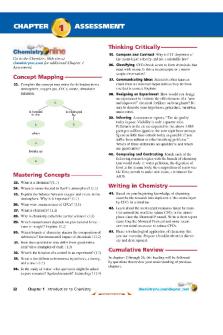Phlebotomy Part 1 PDF

| Title | Phlebotomy Part 1 |
|---|---|
| Course | Medical Assistant |
| Institution | High School - USA |
| Pages | 4 |
| File Size | 288.8 KB |
| File Type | |
| Total Downloads | 21 |
| Total Views | 161 |
Summary
Part One of Phlebotomy notes for Medical Assistant Certification....
Description
Phlebotomy Venipuncture and Phlebotomy •Terms refer to the collection of blood through a tiny incision in the vein; typically with a hollow needle. •Blood can also be collected through simple capillary puncture. •Blood collection allows for blood to be analyzed for abnormalities. •Many different techniques; variety of equipment used. The Medical Assistant's Role or stores the specimen. •MA properly collects, labels, and perhaps processes •MA requires basic knowledge of circulatory A&P, phlebotomy equipment, asepsis, an venipuncture procedures. MA must be professional and have the ability to communicate with the patient and staff •Understanding Circulatory Anatomy and Physiology –Heart is a pump whose job it is to keep blood moving –Arteries ●Have thick elastic walls ●Carry bright red blood ●Actively pulsate from pumping rhythm of heart –Capillaries act as bridges between arteries and veins. –Veins are vessels that carry blood toward the heart. •Main elements of blood include: –Plasma (the liquid portion, which is mostly water) –Formed elements:
●Red cells (with hemoglobin; that transport oxygen) ●White cells (that protect against disease) ●Platelets (that are involved in clotting) •Main elements of blood include: –Blood serum: blood plasma from which fibrinogens have been removed Blood Specimen Collection •Strictly regulated by OSHA. •CDC's standard precautions must be followed at all times. •Laboratories must adhere to CLIA standards. •Type and amount of specimen is dictated by test to be done. –Small volume—capillary puncture –Large volume—venipuncture •Capillary Puncture –Capillary blood used for many home monitoring devices and several CLIA-waived POC tests –Capillaries: microscopic blood vessels that connect the arterioles and venules –Oxygen and carbon dioxide exchanged at the capillary level. –Small amounts of blood can easily be obtained from the capillaries. –Not recommended for tests that require large volumes of blood –Not recommended for plasma studies, dehydration, or poor circulation –Most common capillary puncture sites for adults is the finger (fleshy pad of middle or ring finger) on nondominant hand, off center.
–Earlobe is also common puncture site for adults. –Avoid using the thumb; it is often callused. –Avoid index finger if possible; has extra nerve endings. –Avoid fifth finger; generally has less tissue. –Puncture should be a minimum of 2 mm away from the fingernail. –Avoid any area showing signs of injury or infection. •Capillary puncture on infants –Puncture should occur on the medial and lateral surfaces of the heel. –Patient can be held by parent or caretaker or another MA. –Baby's legs should hang to allow gravity to increase blood flow. –Thoroughly clean and warm the heel before the procedure. –Gentle friction or a warm (never exceeding 42°C, 108°F), moist towel can be applied for three to five minutes to increase blood flow. –Never place an adhesive bandage on patients younger than 2 years; could create a choking hazard. •Equipment and Supplies –Lancet ●Manual or automatic. ●With automatic lancet the depth of the puncture is controlled by a springloaded mechanism, causing less pain to the patient. ●Many are color-coded according to puncture depth they can accomplish. ●Place in a sharps container immediately after use to prevent needlesticks. –Capillary tubes are designed to gently pull the blood into the tiny opening.
–May have a blue mark (plain) or a red mark (with heparin, to prevent clotting). –Microtainer capillary blood collection tubes have a variety of additives, noted by th coded caps. –Unopette collection devices can be used for various blood cell counts. •Venipuncture –Safest and easiest sites to access are located on the upper extremities –Median cubital vein ●Located at the antecubital space, or the inner elbow area ●Most popular –Cephalic and basilic veins ●Next most commonly used; large and superficial Phlebotomist –MA who is trained to perform phlebotomy; may perform venipuncture in the medical o unless state regulations state otherwise. –Practice of phlebotomy also takes place in hospitals, blood banks, reference laborato clinics, and other settings. •Certification in Phlebotomy –Often required at hospitals, blood banks, and independent laboratories –Benefits ●Prestige ●Increased job opportunities ●Higher salary ●Job security...
Similar Free PDFs

Phlebotomy Part 1
- 4 Pages

Phlebotomy Part 2
- 4 Pages

Phlebotomy outline
- 5 Pages

Final Exam FLEB - phlebotomy
- 50 Pages

Phlebotomy Final test
- 13 Pages

CPT-Study-Guide phlebotomy
- 34 Pages

Part 1
- 2 Pages

Module 1 - Assessment Part 1
- 2 Pages

Exam #1 Part 1 Review
- 6 Pages

Makalah part 1
- 14 Pages

INCS-615 part 1
- 23 Pages

Part 1 Compact
- 27 Pages

Poetry Vocabulary (Part 1)
- 1 Pages
Popular Institutions
- Tinajero National High School - Annex
- Politeknik Caltex Riau
- Yokohama City University
- SGT University
- University of Al-Qadisiyah
- Divine Word College of Vigan
- Techniek College Rotterdam
- Universidade de Santiago
- Universiti Teknologi MARA Cawangan Johor Kampus Pasir Gudang
- Poltekkes Kemenkes Yogyakarta
- Baguio City National High School
- Colegio san marcos
- preparatoria uno
- Centro de Bachillerato Tecnológico Industrial y de Servicios No. 107
- Dalian Maritime University
- Quang Trung Secondary School
- Colegio Tecnológico en Informática
- Corporación Regional de Educación Superior
- Grupo CEDVA
- Dar Al Uloom University
- Centro de Estudios Preuniversitarios de la Universidad Nacional de Ingeniería
- 上智大学
- Aakash International School, Nuna Majara
- San Felipe Neri Catholic School
- Kang Chiao International School - New Taipei City
- Misamis Occidental National High School
- Institución Educativa Escuela Normal Juan Ladrilleros
- Kolehiyo ng Pantukan
- Batanes State College
- Instituto Continental
- Sekolah Menengah Kejuruan Kesehatan Kaltara (Tarakan)
- Colegio de La Inmaculada Concepcion - Cebu


